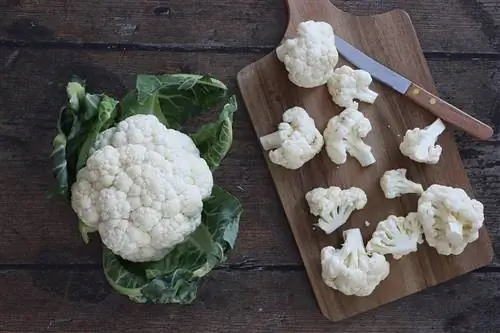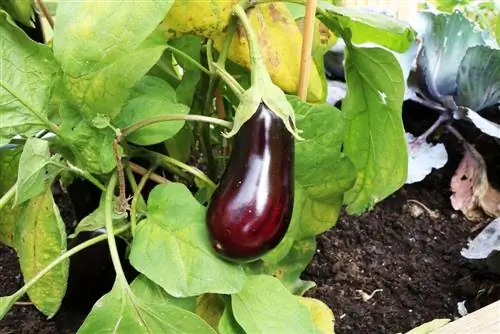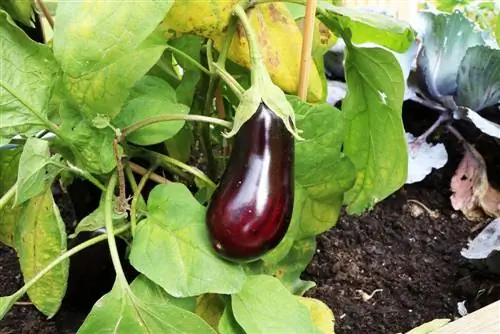- Author admin [email protected].
- Public 2023-12-17 03:39.
- Last modified 2025-01-24 12:45.
Aubergines are he althy, low in fat and calories. Even if they have little taste of their own, they have a pleasant consistency. If you want to enjoy them out of season, you can freeze them.
Suitable fruits
Aubergines are in season from August to October. Fruit that is to be frozen must definitely be fresh and ripe, but not overripe. This is usually not a problem if you harvest your own from your own garden. The situation is different with purchased fruits. A ripe egg fruit has a matt, shiny shell that does not give at all or only slightly when pressed.
If it's too soft or has a spotty shell, it's better to stay away from it. Basically, it is advisable not to buy the largest fruits, but rather the smaller ones. They are usually more aromatic and more intense in taste. Unripe eggplants are not suitable for consumption, neither raw nor cooked. Similar to green potatoes, they contain toxic solanine and bitter substances that make these fruits inedible. When it comes to freezing ripe fruit, different methods are available.
Freeze raw eggplants
Raw-frozen egg fruits are particularly suitable for pureeing, making puree or stewing due to the soft consistency of the pulp after thawing. Commercially available freezer bags, plastic containers or other easily sealable and frost-proof containers are suitable for freezing. When using freezer bags, you should ensure that as little air as possible remains in the bags in order to avoid the formation of condensation as much as possible.
- Harvest eggplants as fresh as possible
- Use only he althy and intact specimens
- Remove stuck-on soil residue with a vegetable brush
- Then rinse under cold running water
- Carefully rub dry
- Peel with peeler or sharp knife
- Peel can develop bitter taste
- Cut into slices or cubes about eight centimeters thick
- Pack in freezer bags in portions
- Seal the bag airtight and put it in the freezer
Tip:
Once the eggplants have been cut, they should be frozen as quickly as possible. If you leave them for too long, they take on a brownish color, similar to apple or potato slices.
Cooking fruit before freezing
So that the meal can be prepared more quickly, you can also prepare the eggplant before freezing.
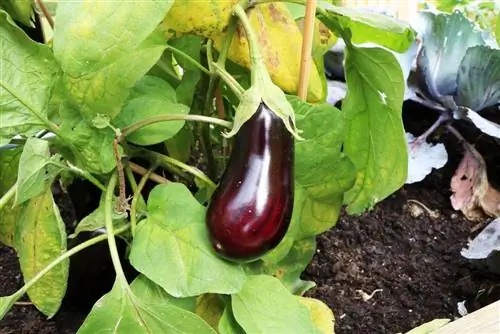
Blanching
Blanching vegetables before freezing is useful because it reduces the activity of certain enzymes that are responsible for the decomposition of the structure and the loss of flavors and vitamins. Here, too, the vegetables are first cleaned and cut into cubes or slices. It's best to only cut as much as you can use immediately. Since the fruits are heated before freezing, they do not need to be peeled.
- Depending on the amount of fruit, add s alt to the water and bring to the boil
- Add lemon juice to avoid discoloration of the fruit pieces
- For three to four liters of water, approx. 125-200 ml lemon juice
- Add eggplant cubes into the boiling water in portions
- Blanch for about three minutes
- Then remove with a slotted spoon
- Immediately place in a container with ice water or ice cubes
- Leave in ice water for about five minutes
- Then pour through a sieve and let drain
- Or lay out on several layers of kitchen paper to dry
- Let cool completely before freezing
- Then into freezer bags or cans and into the freezer
- Stable for up to nine months at minus 18 degrees
- Vacuum packed even up to 14 months
It is also possible to lay out the drained eggplant slices loosely on a flat plate and then place it in the freezer for one to three hours, depending on the size of the slices. The frozen slices can then be packed in freezer bags and put back in the freezer.
Tip:
The water for blanching can easily be reused for up to five times. If necessary, add water and/or lemon juice in the appropriate amount.
Grilling, baking or roasting
Aubergines can also be grilled, fried or baked before preserving or freezing. You can slice them lengthwise or leave them whole. The shell does not need to be removed.
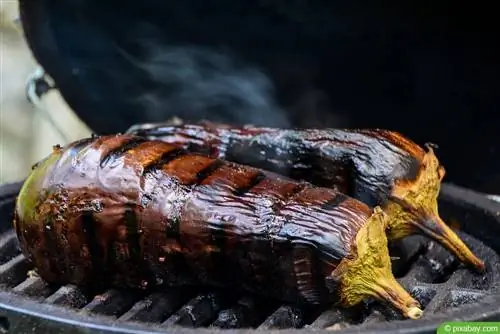
- Slice whole eggplants lengthwise on one side
- Stem base can remain on the fruit, but does not have to be
- Alternatively, cut the egg fruit into slightly thicker lengthwise slices
- Preheat oven to 200 degrees
- Place whole fruit or slices on baking tray
- Brush both all over with oil
- Then bake until golden brown
- Depending on the size of the fruit, approx. 30 to 60 minutes
- Then remove from the oven and let cool down
- Place in sealable freezer bags or plastic box and put in the freezer
- Shelf life is approximately the same as that of blanched eggs
Alternatives to freezing
If too many fruits ripen at once and need to be harvested, you can also extend the shelf life of some egg fruits by drying them. The best way to do this is to cut them into slices again. Drying can be done in the oven, a dehydrator, threaded and hanging or lying on a rack outdoors. The whole thing usually takes several days. Once the slices have dried thoroughly, they can be stored in airtight and ideally opaque containers. Dried eggplants are used like dried tomatoes.
Tip:
Store eggplants in the refrigerator is not recommended. Here the light and pressure-sensitive fruit would take on a rubbery consistency.


